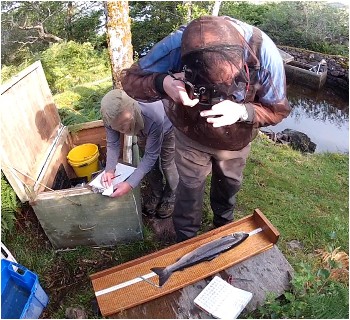Adult salmon that enter the upstream trap at Tournaig are mostly female
Posted: Wednesday 3 October, 2012 @ 18:32:44

The little Tournaig River near Poolewe is one of the smallest river systems within the WRFT area that is known to have supported an Atlantic Salmon (Salmo salar) population. As such, Tournaig represents ‘marginal habitat’ for wild salmon. Since 1999, the Wester Ross Fisheries Trust has operated an upstream – downstream trap in an old fish ladder near the mouth of the river system to learn about salmon and sea trout populations to inform local fisheries managers.
Since 2004, the annual number of adult salmon entering the Tournaig system has varied between a low of 6 fish in 2009 and a record catch of 43 fish (to date) in 2012. Over 94% of these fish were grilse, with a majority entering the upstream trap between the last week of August and the end of September. On checking back over the years, it has become clear that the majority of grilse which have entered the Tournaig system were female fish. Of 187 grilse which were recorded entering the trap during the period 2004 – 2012 (to date), 121 (65%) were classed as female, 52 (28%) were classed as male; and the remainder (7%) were indeterminate. Please click here for article with graphs of adult salmon catches.
Why so many female grilse?
The Tournaig system has remained unstocked, in contrast to the Wester Ross River Carron and Shieldaig systems where salmon and sea trout populations are also monitored. Fluctuations in wild fish numbers at Tournaig therefore relate to factors within the marine and freshwater environment.
We already know that in 2004 and 2005 all the adult salmon that entered the Tournaig system were fish that had strayed into the Tournaig system from other river systems (26 and 36 fish respectively), as no salmon smolts left the Tournaig system in 2003 and 2004 (see WRFT Review May 2008). It seems likely therefore that a many of the adult salmon that entered the Tournaig system in subsequent years were also stray fish (although some of these later fish may have been homing back to Tournaig following years with sizeable smolt runs from Tournaig). One possible explanation is that female fish are more likely to stray away from their natal river (or more likely to get lost on their way home . . . ) than male salmon.
Another explanation is that Tournaig salmon come from rivers where the proportion of male salmon that mature as parr is high. In some situations, 100% of male salmon mature as parr (reviewed by Fleming and Einum, 2011). Smolt runs from such areas may be dominated by females as a result of proportionally higher mortality of male parr than of female parr within the freshwater environment.
In contrast to these observations at Tournaig, in the River Carron in 2011 the majority of rod caught grilse were classed as male and the majority of 2-sea winter fish were classed as female fish (see 2010 & 2011 Wester Ross salmon rod catch comparison article).
Nearly all the Tournaig salmon have been photographed and DNA sampled to enable further investigation.
The Tournaig trap project has been supported by Atlantic Salmon Trust, the Highland Council, Highlands and Islands Enterprise, the Scottish Government and Marine Harvest. Thank you to the National Trust for Scotland and Tournaig Estate for permissions to operate the traps. The traps at Tournaig have been operated by Ben Rushbrooke since 2002. By day, Ben can usually be found at Tournaig Garden Cottage Nursery, http://www.gcnursery.co.uk/ .
References
Fleming, I.A. & Einum, S. (2011). Reproductive ecology: a tale of two sexes. In: Atlantic Salmon Ecology, pp. 33-65 (eds. Ø. Aas, S. Einum, A. Klemetsen & J. Skurdal). Wiley-Blackwell.
Information about the River Shieldaig system can be found at:
http://www.scotland.gov.uk/Topics/marine/science/Publications/FRS-Reports/Shieldaig-Project-Reviews
The River Carron Restoration project website is: